
| Express Shipping: Guaranteed Dispatch in 24 hours |
|
| Item Code: | NAB946 |
| Author: | Ludwik Sternbach |
| Publisher: | Vishveshvaranand Vedic Research Institute, Hoshiarpur |
| Language: | Sanskrit Text with English Translation |
| Edition: | 2021 |
| Pages: | 5238 |
| Cover: | HARDCOVER |
| Other Details | 10.0 Inch X 7.8 Inch |
| Weight | 12.81 kg |
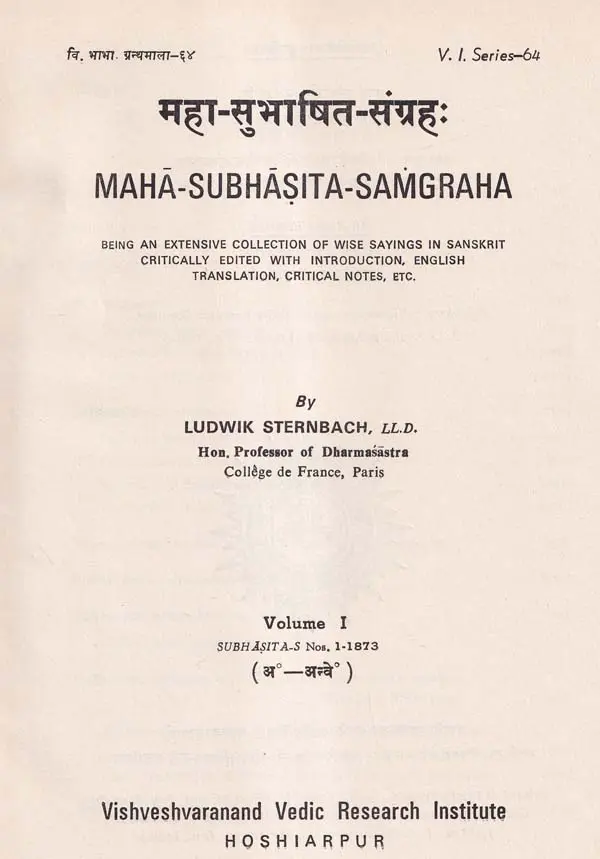
The endeavours of Th. Aufrecht in his "Beitrage zur Kenntniss indicher Dichter" and F. W. Thomas in his Introduction to the Kavindrava cana- samuccaya to give a list of poets quoted in different subhasita-samgraha-s have proved to be very useful for our closer acquaintance with the literature of ancient and mediaeval India. These poets would have been completely unknown to us if their names and verses had not been preserved in the Sanskrit subhasita- samgraha-s and in the subhdsita-samgraha-s of 'Greater India'.
The aim of the present Maha-subhasita-samgraha is to continue to a much larger extent the work begun by Otto Bohtlingk who in three big volumes collected, edited and translated into German 7613 verses (he called them Spruche; but I prefer to call them subhasita-s), as well as of Th. Aufrecht and F. W. Thomas who gave lists of authors quoted in various subhasita-samgraha-s with indications where they occurred.
It has been emphasized several times before that "an up-to-date com- pendium containing all the known subhasita-S arranged in an alphabetical order is still a necessity"3. The opinion has also been expressed several times that if anthologies in Sanskrit were to be exploited in any significant manner for the study of the history of Sanskrit literature (the importance of the subhasita-s for the history of Sanskrit literature is widely admitted), comprehensive indices and con- cordances of all the available anthologies would have to be prepared; they would also provide a compass to those who navigate in the ocean of subhasita literature. The present Maha-subhasita-samgraha is intended to fill this gap.
The work on the present Maha-subhasita-samgraha was started in 1966 and the first volume is appearing only today. First, extensive indices of subhasita-s were to be prepared and then only could the editing of individual subhasita-s be started.
It may be assumed that the entire Maha-subhasita-samgraha will have to be published in some twenty volumes, plus additional volumes for verses which came to be known to me (or in the course of the preparation of the following volumes will come to be known to me) from sources either not published at the time when I started the work or from subhasita-samgraha-s preserved only in manuscripts which I did not have at my disposal at that time" or several subhasita-samgraha-s, the existence of which came only recently to my notice.
The present Maha-subhasita-samgraha is based on all the subhasita-samgraha-s, available to me, which are mentioned in the Introduction below. "At the beginning of each volume, the list of authors quoted in the subhasita-samgraha-s is given and at the end a subject index, since the subhasita-s are quoted in alphabetical order and not according to subject matters. The alphabetical system seems to be particularly convenient for philological studies and for the easier finding of the subhasita-s, provided that a subject index is also attached for those who want to find references to a specific topic and particularly for non-specialists who may find the Maha-subhasita-samgraha useful for the study of Indian civilisation.
As mentioned in the Introduction (para 12.1), there exist three groups of subhasita-samgraha-s: (1) those composed virtually of sententious sayings; (2) those composed virtually of quotations from literary works, particularly "beautifully turned" and eloquently said, as well as dealing with the description of nature, different moods, suggestions or anyokti-s and (3) mixed, i.e., including both types of subhasita-s. The present Maha-subhasita-samgraha belongs to the third category and contains not only wise sayings, but also stray poetical verses. That seemed to me to be necessary, since most of the Sanskrit subhasita samgraha-s belong to the third group of anthologies and one of the aims of the present work is to include in it, among others, all the verses quoted in the already known subhasita-samgraha-s.
All subhasita-s included in the subhdsita-samgraha-s are quoted and edited 'in the Maha-subhasita-samgraha, though some, from the poetical point of view, may not be considered as "subhasita-s. Not all subhasita-s found in the subhasita-samgraha-s are wise sayings} nor pure poetry,3 but, being considered as useful by the compiler of a subhasita-samgraha, were included by him in his anthology' and therefore included in this Maha-subhasita- samgraha: they should not, however, be included in an anthology of poetry par excellance.5 Even not all "poetical subhasita-s" have a great poetical value and, thus, might be considered as "useless,"' but since they were already included in a subhasita-samgraha, they are also included in the present Maha-subhasita- samgraha. Also for the same reason some subhasita-s included in subhasita- samgraha-s, though incorrectly construed are reproduced in the present work.
In addition to Sanskrit subhasita-s cited in Sanskrit subhasita samgraha, subhasita-s also from subhasita-samgraha-s known in `Greater India if they were translations or adaptation of Sanskrit texts, were included in the present work, even if they are unknown today. Therefore, we find, for instance, in the Maha-subhasita-samgraha verses from the Nitisastra of Masuraksa (e.g., No. 569), the original source of which is not known, In addition to the subhasita-s included in the various subhasita-samgraha-s, a great part of Sanskrit literature was studied by me and subhasita-s (wise sayings and some descriptive verses) from these works were culled and quoted in the Maha-subhasita-samgraha. The choice was made by me and I alone am responsible for the selection. I expect criticism in this respect and questions why I chose one verse and omitted another. Many of these criticisms will be well taken, but what is pleasing to one person does not need to be pleasing to another. All the criticisms will be welcomed and suggestions will be gladly received; the subhasita-s additionally suggested might then be added in the supplementary volume(s) with the name of the proposer.
The original plan of the work was to collect and critically edit the subhasita-s. The publisher insisted, however, that a translation of each verse should be supplied; he thought that the Maha-subhasita-samgraha would also appeal to non-specialist whose knowledge of Sanskrit is limited. I reluctantly agreed to this suggestion, but felt that I alone would not be able, in view of the enormous task before me, to cope with both the collecting and editing as well as translating. Therefore, whenever I found an English translation of a subhasita, already prepared by a Sanskrit scholar, I included it in the Maha-subhasita- samgraha: subhasita-s which I particularly liked and especially those belonging to the collections of wise sayings attributed to Canakya (and which I started to trans- late already) I translated myself. The remaining subhasita-s was translated by Mt. A.A. Ramanathan of the Adyar Library and Research Centres who consented to translate them for the Maha-subhasita-samgraha. I wish to present my wholehearted thanks to him for the work done.
I also wish to express my infinite gratitude to Pandit Dr. K. P. Aithal, at present Professor of Indology at the University of Heidelberg, for his gracious and valuable advice and help in the preparation of the present volume of the Maha-subhasita-samgraha. His suggestions were always to the point and were readily accepted by me. I also take this opportunity to express my sincerest thanks to Dr. S. K. Chatterji, National Professor of India in Humanities; Dr. R. N- Dandekar, Professor at the University of Poona ; Dr. Gauri Nath Shastri, former Vice-Chancellor, Sanskrit University, Varanasi; Dr. V. Raghavan, former Professor and Head of the Department of Sanskrit, University of Madras; Sri K. V. Sarma, Reader, Vishveshvaranand Institute, Punjab University; and Dr. Vibhuti Narain Singh, former ruler of Banaras, Chairman of the Board of Trustees of the All-India Kashiraj Trust, Varanasi for providing me useful information and helping me otherwise, in various ways, in the production of this work. I am beholden to the late Acarya Dr. Vishva Bandhu Sastri, former Joint Secretary and Director of the Vishveshvaranand Vedic Research Institute, who always supported me in my plan and endeavours relating to the Maha-subhasita-samgraha and I am happy to add that I continue to receive the same help and encouragement from his worthy successor Principal Rala Ram. Sri S. Bhaskaran Nair, Deputy Director, Vishveshvaranand Vedic Research Institute, has been my right hand in the matter of seeing the work through the press. I am extremely glad to note that the present work has been greatly benefited by the expertise which Sri Nair has brought to bear in its editorial processing and final presentation. Finally, I wish to express my thanks to the Vishveshvaranand Vedic Research Institute, Hoshiarpur for accepting the manuscript of the present volume for publication, despite the high cost of printing and the rather cumbersome nature of the manuscript.
The Maha-subhasita-samgraha is construed in the following manner. Each subhasita has a serial number} the text with the indication of the source follows: for details on the latter the "Abbreviations" and Index of Authors and Sources of Individual verses (pp. 319-379) should be consulted. The sources are divided into three categories: primary sources, denoted by a : secondary sources, denoted by aa; and sources from 'Greater India' denoted by e then variants are registered and the name of the metre used is given; and finally the English translation with the name of the translator in brackets at the end of the translation is supplied. (For the bibliographical data of the translators the "Abbreviations" should be consulted).
In each volume of the Maha-subhasita-samgraha the following items are also included:
1. A list of abbreviations which serves also as a guide for bibliographical data of the sources quoted and on their translations.
2. An index of author and sources of individual subhasita-s included in the volume. This list contains the minimum necessary information about each author or source cited, as well as bibliographical references to more detailed information about these authors and sources. At the end of each entry numbers of verses cited in the volume where the authors and / or sources are quoted is given, as well as (in brackets) the subhasita-samgraha-s in which the appropriate subhasita occurs. This list might be of value for students of the history of Indian literature, since it will give references also to poets who are generally unknown and are quoted exclusively in subhasita-samgraha-s.
3. An index of metres other than sloka-s or anustup-s used in the subhasita-s quoted in the volume, the reference numbers of the corrupt metres being given in italics.
4. A subject index of the subhasitas quoted in the volumes. It is intended to prepare a collective subject-index of all the volumes on the completion of the Maha-subhasita-samgraha.
The importance of the project Maha-subhasita-samgraha as an outstanding work of research in the field of Sanskrit Niti-literature as well as in the domain of Indian civilization and cultural history has since been widely acclaimed both by individual scholars and learned bodies at the national and the international levels.
Out of the contemplated 20 volumes of this project, the Volume I consisting of 1873 verses was issued by our Institute in 1974 and the Volume II, issued now, incorporates further 2335 verses raising the total number of verses so far treated in the first two volumes to 4208 and covering the text of the subhasita's upto namely, all the verses beginning with the first letter of Devanagari alphabet.
The subhasita-s constitute a characteristic type of Sanskrit literature which aims at conveying ancient Indian wisdom and glorious thoughts through highly suggestive and meaningful words expressed in an attractive style and, as such, form one of the foremost branches of Sanskrit literature. The publication of a comprehensive collection of all such subhasita-s and other entertaining verses of Indian origin with translation into a modern language like English and provided with relevant Critical Notes and Indices in respect of each verse included therein is, therefore, a long-felt need. This desideratum is being fulfilled through the present project of the Maha-subhasita- samgraha.
Out of the proposed 20 volumes of this project, Volumes I and II containing 4208 verses and extending the text of the subhasita-s upto all? were issued by our Institute in 1974 and 1976, respectively. Volume III, issued now, incorporates further 2077 verses raising the total number of verses so far treated in the first three volumes to 6285, covering all the verses beginning with the first four letters of the Devanagari alphabet.
Of the Maha-subhasita-samgraha, the extensive collection of wise saying and entertaining verses in Sanskrit, intended to be issued in twenty volumes, Volume III. which is now being placed before scholars, contains over two thousand verses, Nos. 4209-6285, beginning with the Devanagari letters aa, e and eai In the compilation of this volume, in addition to the source materials used in the previous volumes, relevant materials extracted from certain extra sources have also been utilized. While the printing of the present volume was in progress, I was engaged also in preparing a two-volume Descriptive Catalogue of Authors Quoted in Sanskrit Anthologies And Inscriptions, to be published shortly by Ms. Otto Harrassowitz, Wiesbaden (W. Germany). Studies in this regard had enabled Me to revise and expand substantially, the "index of Authors ant; Sources of Individual Verses" included in the present Volume (pp. 1493-1558). Readers of Vols. I and II of the Maha-subhasita-samgraha are, therefore, requested to consult also, with advantage, the relevant Index in the present volume for additional information.
In the present volume, special attention had been paid to the presentation of the materials included, viz., the original terse; their translation, varia lexica and the Indices, in which I received active collaboration from Sri S. Bhaskaran Nair, Director of the V. V. Research Institute. It was he who checked the textual verses and fixed the readings in a number of doubtful verses, suggesting suitable emendations and revising the Critical Notes accordingly with the addition of necessary explanations in the Footnotes; touched up inelegant translations besides himself translating a large number of verses; and verified and revised, as necessary, the different Appendices to this volume. It is my pleasant duty to record my infinite gratitude and sincerest appreciation for the strenuous editorial work which Sri Nair has performed in a most scholarly manner towards making this volume more perfect and handy to the cultured reader. The credit of seeing this publication through the press and seeing to its elegant get-up also goes to him. In short, the present work of mine has been immensely benefited by the vast experience which Sri Nair possesses in editing Indological research works.
My thanks are due, in full measure, also to Sri K.V. Sarma, Acting Director, the V.V.B. Institute of Sanskrit and Indological Studies, Punjab University, for making available to the Editor his expert advice, time and again, towards the scholarly presentation of the volume.
The V V. Research Institute had brought out the First Volume of the Maha-subhasita-samgraha in 7974, the Second in 7976 and the Third in 7977 through its Vishveshvaranand Indological Series as Nos. 64, 69 and 77, respectively. The Volume IV is being issued as No. 73 of the said Series. It is a matter of gratification for the institute that the earlier three volumes of the work had been received warmly both by the Sanskrit scholars and by the general reading public, as attested by the reviews of the said volumes published in prominent periodicals and the approbatory correspondence on these volumes received in the institute Office. The present volume takes off from where the third volume had ended and records 2000 verses, numbered 6286 to 8264, beginning with the Devanagari letters including 27 extra verses. It is to be hoped that this Volume will receive from its cultured readers the same approbation as was accorded to the earlier volumes.
The Maha-subhasita-samgraha, Volume IV, is being issued by I the V. V. R. Institute, as No. 73 of its Vishveshvaranand Indological Series. It is a matter of gratification for this Institute that the earlier three volumes of the work had been received warmly both by the Sanskrit scholars and by the general reading public, as attested by the reviews of the said volumes published in prominent periodicals and the approbatory correspondence on these volumes received in this Office. The present volume takes off from where the third volume had ended and records 2000 verses, numbered 6286 to 8264, beginning with the Devanagari letters including 21 extra verses.
The pattern adopted in the previous volumes has been followed in the present volume too._ The wise sayings and entertaining verses, as culled from a wide variety of texts, including those of Indian origin preserved in the 'Greater Indian' literatures, such as those of Tibet, Ceylon, Indonesia, Cambodia and other countries, have been carefully edited and presented in Devanagari characters, with the indication of their primary, secondary and 'Greater Indian' sources. This is followed by the variant readings found in the different sources; A readable I translation of the Sanskrit text into English follows, enabling the non- Sanskritist reader to grasp the innate wisdom and poetic charm contained in the verses. Short notes, in the form of footnotes, are added, wherever necessary, to explain contexts, indicate the persons referred to and point out allusions. Three indexes have also been compiled for the volume, being: I. Index of Authors and Sources, wherein brief details of the individual authors and also of the works are given, with the enumeration of the verses under their sources; II. Index of Sanskrit Metres, wherein the verses couched in the same metre, other than Anustubh, have been collected and enumerated; and, III. Subject Index, in which the innumerable topics dealt with or referred to in the verses have been indentified and indexed alphabetically, with cross references wherever needed. It is to be hoped that this Volume will receive from its cultured readers the same approbation as was accorded to the earlier volumes.
The painstaking labour that Dr. Ludwik Sternbach has put in towards the preparation of this volume is better visualised than stated. Our Institute is highly indebted to Dr. Sternbach for compiling this Volume for publication by the Institute. While the present writer has had the privilege of editing the Volume intensively, revising entries as needed, supplying short notes and fresh translations wherever necessary, checking references and variant readings, and seeing the publication through the press, he had always at hand the unstinted co-operation of Dr. K. V. Sarma, Director-Professor of the sister institution, the Vishveshvaranand Vishva Bandhu Institute of Sanskrit and Indological Studies. Thanks are, again, due to Dr. Sarma for the help he rendered towards the compilation of the Subject Index.
The V.V. Research Institute had brought out the First Volume of the Maha-subhasita-Samgraha in 1974, the Second in 1976, the Third in 1977 and the Fourth in 1980, through its Vishveshvaranand Indological Series as Nos. 64, 69, 71 and 73, respectively. The Volume V is being issued as No. 75 of the said Series. It is a matter of gratification for the Institute that the earlier four volumes of the work had been received warmly both by the Sanskrit scholars and by the general reading public, as attested by the reviews o the said volumes published in p prominent periodicals and the approbatory correspondence on these volumes received in the Institute Office. The present volume takes off from where the Fourth volume had ended and records 2000 verses, numbered 8265 to 9979, beginning with the Devanagari letters ka to kaa, with a number of extra verses interspersed between the regularly numbered verses. It is to be hoped that this volume will receive from its cultured readers the same approbation as was accorded to the earlier volumes.
Volume V of the Mahasubhasita-Samgrahn is being issued under the most painful circumstances. Dr. Ludwik Sternbach, the author of the Volume, passed away suddenly on March 25, 1981, when the printing of the Volume was yet to commence May be that h was not in the best of health, but he seemed to have a premonition of what was to come. For, he wrote in his letter from Turin, dated 28. 12. 1980, addressed to Dr. K. V. Sarma, who was to vet and edit the Volume 1 "The last wish of mine is that Vol. V of the Mahasubhasita-Samgraha appears for the V World Sanskrit Conference in Varanasi and that you work on it with full speed. I beg you to do it." He added in the same letter, "I do hope that I shall be able to return to Paris, but I doubt that I shall survive the operation to be undertaken, probably some time in the second half of January. So, reply to me as soon as possible." He said further, "I have also made arrangements that my fortune (with the exception of other bequeaths to my family and friends which I have made) be given, after my death, to the "Dr. L. Sternbach Foundati0n" to be administered by the Vishveshvaranand Vedic Research Institute in Hoshiarpur for the continuation of the Mahasubhasita-Samgraha," being the fulfillment of a pious promise which he had made to the Institute, as early as in i973, while persuading the Institute to accept his Mahasubhasita-Samgraha, for publication.
True to its academic tradition, the Institute immediately wrote to Dr. Sternbach a most reassuring and comforting reply wishing him full recovery and stating that the Institute would undertake the responsibility of continuing his great work in the lines that he had set out and that he would have the satisfaction of, seeing Vol. V of the work being issued on the occasion of the Y World Sanskrit Conference. It is a matter of great grief that Dr. Sternbach is not alive to witness the publication of his work, though the V.V. R. Institute has seen to it that it was issued as he had desired.
The timely issuance of this Volume is due also to another fortituous circumstance. Br. K.V. Sarma, whose scholarly advice was available to the undersigned in vetting and editing the previous four volumes of the work to the entire satisfaction of Dr. Sternbach, retired on 1. l. l9S0 as the Director-Professor of the University Wing of the Institute and the undersigned had to shoulder the responsibilities of that Wing, with the result that work on the Mahasubhasita-Samgraha came to a standstill. In the meanwhile, Dr. Sarma had accepted the assignment as Academic Adviser to the well-known firm of Indological publishers, Ms. Motilal Banarsidass. Dr. Sternbach was, naturally, insistent upon his work being resumed and, in the changed circumstances, preferred Dr. Sarma to take up the editing of the work. Therefore, the Institute invited Dr. Sarma to rejoin it and it goes to the credit of Dr. Sarma that he paid heed to that invitation, gave up his lucrative job and assumed charge of Dr. Sternbach's work, as a labour of love, on account of his addiction to academic pursuits.
The present Volume of the Mahasubhasita-Samgraha which is issued as No.75 of the Vishveshvaranand Indological Series, records about 2000 wise sayings and entertaining verses in Sanskrit beginning with the Devanagari letters ka and kaa, numbered 8265 to 9979, with a number of additional verses inserted between the regularly numbered verses. The pattern of presentation is the same as in the previous volumes. The verses as extracted from the extant subhasita works and poems in Sanskrit and from texts of Indian origin preserved in Greater Indian literatures such as those of Tibet, Ceylon, Indonesia, Cambodia and other countries, have been carefully edited and presented with the documentation of their primary, secondary and Greater Indian sources. This is followed by the textual variants found in the different sources. A readable translation of the Sanskrit text into English follows, enabling the non-Sanskritist reader to grasp the innate wisdom and poetic charm of the verses. Footnotes are added wherever necessary to explain contexts, indicate references and point out allusions.
Three Indexes are appended to the Volume, being: I. Index of Authors and Sources, wherein brief details of the individual authors and also of works from which the verses have been extracted are given with the enumeration of the verses concerned; II. Index of Sanskrit Metres, wherein the verses in the different metres, have been listed; and, III. Subject Index, in which the innumerable topics dealt with or referred to in the verses have been identified and indexed alphabetically with cross-references. It is to be hoped that this Volume will receive from its cultured readers the same welcome as was accorded to the earlier volumes.
The painstaking labour which Dr. Sternbach has put in towards the compilation of this Volume is better visualised than stated. Dr. K. V. Sarma, with his characteristic enthusiasm and devotion to work, has edited the verses intensively, checking the entries and the references, vetting translations and adding notes, when required. He has also himself translated a large number of verses and has prepared the three Indexes to the Volume. The credit of the neat printing of the work in the course of a few months goes to the workers of the V. V. R. I. Press.
Before I close, I desire to mention that, in accordance with the wishes of Dr. Sternbach, this Institute has set up a Dr. Ludwik Sternbach Foundation with the primary object of continuing the compilation and publication of the 20-volume series of Mahasubhasita- Samgraha, the completion of the unfinished writings of Dr. Sternbach and pursuance of editing and research in the realm of Indian anthological literature. We appeal to all lovers of Sanskrit and Indian culture and also scholars in general to help in the activities of this newly started Foundation. In fact, we would be thankful to our readers for any constructive suggestion or academic and other contribution that they could render in the above behalf and thus Maha. V-ii help us to fulfill the mission which savant Dr. Ludwik Sternbach stood for.
Perhaps next to the demise of its Founder-Director Acharya Dr. Vishva Bandhu in 1973 and of its benign President Diwan Anand Kumar in 1981, the V.V. Research Institute has sustained the most severe blow in the sudden demise of Dr. Ludwik Sternbach, a close associate, friend and benefactor of the Institute, on March 25, 1981. He passed away as the result of a heart attack as he was returning taxi after attending a meeting in Paris. He was a devoted researcher and an indefatigable worker. He bore a charming personality, affable, affectionate and disarming, qualities which his close friends and fellow-workers, including the present writer, can vouch for.
Dr. Sternbach's life and career were highly varied and eventful. He was born in Cracow (Poland) on Dec. 12, 1909 as the son of an eminent lawyer and studied law in the Jegellonian University at Cracow (1927-30). On passing out of the University, he worked in a judicial court (1931-32), then under a local lawyer (1932) and commenced independent practice as a Member of the Bar at Cracow in 1937. His interest in Indian culture and law prodded him to study Sanskrit, which he did under Prof. Mme. de Helena Willmann-Grabowska of the Department of Indian Philology, combining his studies with his profession. He took his LL.D. in 1933 and Ph.M. (Philosophy and Sanskritology) in 1936, his specialisation being Dharmasastra and Arthasastra. Since his Professor was the lone member of the staff of the Department, he volunteered to assist in giving lectures and looking after the Library 1933-37), when he was taken as a Reader in the Department (1937-38).
In the wake of the Nazi occupation of Western Poland and persecution of Jews, Dr. Sternbach escaped penniless (1939) to Lwow in Eastern Poland, then under Russian occupation. At Lwow he got an Assistant's job under Prof. Stefan Stasiak in the Institute of Indian Philology and Culture of the University of Jan Casimir (now Iwan Franko). When things began to hot up there, too, he left Lwow and reached India via Turkey and Iraq, suffering manifold difficulties on the way.
In India, the Bharatiya Vidya Bhavan, Bombay gave asylum to this academic pilgrim and he was accepted as Professor of Dharmasastra and Indian Culture. In this capacity he became associated also with the Bombay University. The seven years (1940-46), which he spent in India, lecturing in the said two institutions, visiting other University centres, and associating with Indian scholars, was the most formative period in the academic career of the ardent aspirer after learning that Dr. Sternbach was. Thus, when the UNO was set up after the Second World War and Dr. Sternbach was drafted to it, in 1947, as Deputy Director of Research in the Department of Trusteeship on Non-Self-Governing Territories, he left India not only as a Dharmasastra-vidvan, but also as a Loka-katha-vidvan (Master of Indian folk-tales). Throughout his tenure in the above and senior capacities in the UNO at Paris, Geneva and New York, Dr. Sternbach continued, with zest, his Indianistic studies, which led him to still another allied field, viz., the rich subhasita literature in Sanskrit and developed into a Subhasita-vidvan too. His literary output and published writings during his tenure in the UNO from 1947 to 1970 is so prodigious that he seemed to have pursued his academic studies with as much interest and ardour as his official duties.
When his term of Office at the UNO came to a close in 1970, he joined the University of Sorbonne Nouvelle, Paris, as Professor of Indology, where he lectured on Indian Culture for two years (1970-72) and later in the same capacity in the College de France for four years (1972-76). During the last years 0f his life, he maintained close, though informal, connection with the said institutions and pursued his academic studies and publication activities unremittingly. Throughout his life, he suffered from poor health and impaired vision but that did not deter him from world travel, frequent visits to India and lecturing at Universities and Institutes in the countries that he visited.
While the subjects taken up for study by Dr. Sternbach were more of a general than of a technical nature, what was lost in depth was amply made up in expanse. Thus, the published writings of Dr. Sternbach is, to say the least, stupendous both in bulk and in variety. More than thirty titles, in about fifty volumes, some of them extending through a few hundred pages each, besides a hundred and fifty scholarly papers and over two hundred literary reviews is, indeed, an enviable record even for an assiduous academician. His early writings centered round the gnomic and didactic, and sociology, law and politics, in ancient India. While he presented through the 6-volume Canakya-niti-text-tradition (Hoshiarpur, 1963), and other similar text-editions, pithy Sanskrit texts prescribing the path of righteousness and avoidance of pitfalls in life, in his exegetical works like the 2-volume Juridical studies in ancient Indian law (1965, 1967), he correlated those texts with social customs and legal tradition of the land according to the Dharmasastras and Smrtis. His Bibliography of Kautilya's Arthasastra (Hoshiarpur, 1973) and Bibliography of Dharma and Artha in Ancient India (Wiesbaden, 1973) are very useful reference books on the subject.
From amongst his works on Sanskrit subhasita, three deserve special mention. First, his two substantial Supplements (Wiesbaden, 1965; Turin, 1974) to the well-known Indische Spruche by O. Boehtlingk. The second is his 2-volume Descriptive catalogue of poets quoted in Sanskrit anthologies and inscriptions (Wiesbaden, 1978, 1980), which forms the largest ever detailed documentation of about 2000 authors, many of them known only through their stray verses. The third is Mahasubhasita-Samgraha, his magnum opus, a 20-volume "extensive collection of wise sayings and entertaining verses in Sanskrit, with Introduction, English translation, Critical notes and Indices." Four volumes of this work, each containing live to six hundred pages, had already been issued by the V.V. Research Institute, Hoshiarpur and further volumes were under preparation when the hands of death snatched away Dr. Sternbach in the midst of his work. Possibly, he had a premonition of his death, for he entrusted the continuation of the compilation and publication of this priceless project to the V. V. Research Institute, through a 'Dr. Ludwik Sternbach Foundation', which the Institute has since set up.
Dr. Sternbach was a member of several learned bodies and was the recepient if several honours, but what he cherished most were the honorary doctorates which the Sampuranand Sanskrit University, Varanasi and the Kameshwar Singh Sanskrit University, Darbhanga, conferred in him, both in 1980, mainly in consideration of this work on the Mahasubhasita-Samgraha. It may be pertinent to name here some of the Indological research institutions in India with which Dr. Sternbach had the closest academic association, viz., V. V. R. Institute, Hoshiarpur, All-India Kashi Raj Trust, Varanasi, Bharatiya Vidya Bhavan, Bombay, the Bhandarkar Oriental Research Institute, Poona, and Akhila Bharatiya Sanskrit Parishad, Lucknow.
Soft-spoken, pursuasive and unbelievably courteous, this Senior Officer of the UNO who has achieved, in the literary field, perhaps, more than a well-placed academician, has left a void in Indological scholarship. Indeed, his numerous friends and admirers, both in India and in the West, will miss his benign presence in the sessions of the World Sanskrit Conference, of which he was the Secretary-General and the live force.
.The Work projected
The prime purpose of the projected Maha-Subhd5ita-Samgraha is to put forward, in a systematic manner, the wit and wisdom of India's glorious past as contained in the vast expanse of Sanskrit literature, With this end in view, in the preparation of the present work, an earnest endeavour has been made to collect, classify, edit critically with detailed references and text- comparative annotations, translate into English, arrange and present in the Devanagari alphabetical order the ethical, scientific and other delightful sayings of metrical composition available in India, and also in 'Greater India' comprising the countries like Tibet, Burma, Ceylon, Thailand, Cambodia, Indonesia, Laos, etc. where Sanskrit literature along with Indian civilization and -culture had spread in early times. Further, a complete list of Bibliography and as many as three Indexes, to wit, 1. Index of Authors and Sources, 2. Index of Metres, and an exhaustive Subject Index appended to each volume make the work an indispensable book of reference in the field of Subhasita-section of Sanskrit literature as well as in the domain of socio-cultural history of India.
The Work produced
Out of the contemplated 20 volumes of this gigantic Project, the V.V. Research Institute had brought out Volume I (pp.592) in 1974, Vo1.II (pp. 616) in 1976, Vol. III (pp. 576) in 1977, Vol. IV (pp. 584) in 1980 and Vol. V (pp. 510) in 1981, and these five volumes contain, altogether, 9979 verses. .The present Volume VI incorporates, in 592 pages. further 1512 verses and also 77 extra verses, raising the total number of verses so far treated in the first six volumes to 11491 (excluding the inserted additional verses), covering all the verses beginning from a to kai in the Devanagari alphabetical order.
I feel very great pleasure and consider it a veritable privilege to contribute a Foreword to this Volume of the Maha-Subhasita- Samgraha, planned and partly compiled by the late Professor Ludwik Sternbach and being so ably edited and presented to the world of the learned by Prot`. S. Bhaskaran Nair, Director-Professor of the V.V.R.I., Hoshiarpur. It is a matter of delight for me to be fortunate to witness the fructification of a proposal mooted by the learned Professor Sternbach and discussed with me as far back as September, l966. He was then in search of a scholar, who would translate into English those subhasitas which had not so far been translated into English, edits the Sanskrit text critically and see the work through the press. He had himself found such a scholar in Prof. Bhaskaran Nair. On his way to New York, he communicated his wish to me in his letter dated 24. 9. 1966 as follows: "I would greatly appreciate it if he (Mr. Bhaskaran Nair) would be able and willing to undertake the job, since I have full confidence in him and have high esteem for his work."
Needless to say that it was beyond my power to request and persuade the late lamented Acharya Vishva Bandhu Ji to spare Mr. Bhaskaran for this work and six long years passed. On 28th August, 1972, Prof. Sternbach again wrote to the late Acharya Ji that the Maha-Subhasita-Samgraha was for him like a child and he intended to bequeath the whole of his fortune after his and his mother's death to the Institute which will take up the publication of this work. Thus Prof. Sternbach succeeded in persuading the late Acharya Ji to agree to the publication of this great Project by the V.V.R.I. In this way, Prof. Sternbach's ardent wish to entrust the editing and the preparation of the final text and its publication to Prof. S. Bhaskaran Nair was ultimately fulfilled.
Prof. Bhaskaran has spared no pains to make the work a model of critical editing and excellent referencing. Besides vetting and touching up, as necessary, the translations of the various scholars included in this Volume, he himself has translated a substantial number of stanzas. He has more than fulfilled the cherished wishes of Prof. Sternbach who was pleased to place on record his discerning appreciation of Prof. Bhaskaran's work in the Acknowledgements prefixed to the Second Volume in the following words: "My most whole-hearted thanks and words of appreciation go to Shri S. Bhaskaran Nair, who edited the present Volume to my entire satisfaction. He has carefully gone through the whole work, and has been making extra-corrections and additions with regard to the Sanskrit text, Notes, Metre, Translation and Indices. He has also made numerous scholarly suggestions which were always useful. I wish to place on record my never-to-be-forgotten gratitude to Shri Nair,"
In the present Volume there are 1589 verses culled from over 800 Sanskrit works. Their text has been critically edited and a complete bibliographical and text-comparative data has been furnished. In the case of doubtful text of verses, very intelligent textual emendations have been made. Besides a lucid English translation, a detailed investigation into the complicacies of metre has been gone into and additional information, wherever necessary, has been supplied in the form of foot-notes.
There are two very useful appendices. In the first of these the editor has given a consolidated list of Abbreviations including in it the Abbreviations already given in Volumes I to IV. This not only makes the list complete and this Volume self sufficient, but also makes the task of referencing easier and it also serves the purpose of a Bibliography. In the second appendix, the names of the authors and the sources of the verses included in the present Volume VI have been documented, The minimum requisite information about the authors, and source-works has also been provided. For further information regarding the relevant authors and sources, necessary references have been made to the two volumes of Prof. Sternbach's A Descriptive Catalogue of Poets quoted in Sanskrit Anthologies and Inscriptions, published during 1978-80 from Wiesbaden, where details of anthological and inscriptional poets have been fully recorded; and also to Aufrecht's Catalogus Catalogorum as well as to New Catalogus Catalogoram by Prof. V. Raghavan and Prof. K. K. Raja. Published, in several volumes, by the Madras University. There is a classified Index of Metres and also an exhaustive Subject Index which further enhance the reference-value of the work as a source-book of information on a variety of subjects connected with important aspects of men and matters. Prof. Nair's meticulous textual-criticism, his command of English and the copious referencing have gone into the making of this Volume a fine literary achievement, worthy of the author-Prof. Sternbach as well as of the V. V. R. Institute under the auspices of which it is being published.
The volumes already published under Prof. Bhaskaran's masterly editorship have elicited unequivocal praise from eminent Indologists like Prot. J. Gonda of Utrecht, Prof. Pratap Bandyopadhyaya of Burdwan, Prof. P. K. Narayana Pillai, former Dean of Oriental Studies of the University of Kerala, and Dr. B. N. Shukla, former Vice-Chancellor of Sampurnanand Sanskrit University, Varanasi, I express my deep appreciation of the excellence of the high literary standard maintained by Prof. Bhaskaran in bringing out these volumes of the Maha-Subhasita-Samgraha and I must offer to him my heartiest congratulations on his fine performance.
The Work Contemplated
The Mahasubhasitasamgraha project is the P second big project after the famed Vedic 5 Word- Concordance project undertaken by the V.V. Research Institute. In its preparation, an earnest endeavour has been made to collect, classify, edit critically with detailed references and text-comparative data, translate into English, arrange and present in the Devanagari alphabetical order the wise sayings of metrical composition and the entertaining verses of poetic fascination in Sanskrit as available in India and also in 'Greater India` comprising the countries like Tibet, Sri Lanka. Burma, Thailand, Cambodia, Indonesia, Laos, etc. where Sanskrit literature along with Indian civilization and culture had spread in early times. Further a complete list of Bibliography and various Indices appended to the volumes enhance the reference-value of the work as a literary source in the domain of socio-cultural history of India.. The project when completed would certainly be a landmark in the history of Sanskrit studies in modem times with a particular reference to the field of Subhasita section of Sanskrit literature.
The Work Completed
Out of the expected 20 volumes, the Institute had brought out Vol. I (pp. 592) in 1974, Vol. II (pp. 616) in 1976, Vol. III (pp. 576) in 1977, Vol. IV (pp. 584) in 1980, Vol. V (pp. 510) in 1981 and Vol. VI (pp. 592) in 1987. The present Volume VII incorporates, in 688 pages, 1528 verses raising the total number of verses so far treated in the first seven volumes to 13018 excluding the inserted extra verses and covering. in 4158 (248 + 3910) pages, all the verses beginning in the Devanagri alphabetical order.
It was 1976. The All-India Oriental Conference was meeting at Dharwar. I was presiding over its Classical Sanskrit Section. The second volume of the Mahasubhasitasangraha had just come out. I referred to it in my Presidential Address and spoke of the entire project as 'monumental'.
Much water has flowed down the Yamuna since then. A good twenty-three years have sped by. The Mahasubhasitasangraha has come up to six volumes. The seventh one, which I have the pleasure to introduce herewith, is all set to appear in print shortly.
The Mahasubhasitasangraha project is the second big project after the famed Vedic Word-Concordance project undertaken by the Vishveshvaranand Vedic Research Institute, Hoshiarpur. Expected to run into twenty volumes, it has been making steady progress, thanks to the single minded dedication of its editor Prof. S. Bhaskaran Nair. He has been editing its Sanskrit text with necessary corrections and additions, providing text-comparative data, suggesting emendations in cases of doubtful readings, supplying notes on various matters including metres and compiling indices. He has also been translating a huge majority of the subhasitas into English, a task daunting enough in view of their laconic nature and the diffused construction at times.
While the scholarly community would expect the project to gather a little more of speed, it has also to come to terms and appreciate the constraints under which it is operating. When one single individual is to carry the major responsibility of supplementing, editing, translating, index-making and seeing the work through the Press, the progress cannot but be slow. It is a monument of wonder that so many volumes of the monumental Mahasubhasitasangraha could at all make their appearance. Scholarly community owes to Prof. S. Bhaskaran Nair its profuse thanks.
A good statement, a wise saying is designated in Sanskrit by two terms : subhasita and sukti. There is a vast number of them in Sanskrit literature. They figure in it in two forms: direct and indirect; direct in didactic works, the Niti texts and in good measure in tales and fables; in indirect form in Anyoktis or in Arthantaranyasas, general statements in support of specific ones or as sequels, as a sum up as it were, to given situations. In both the forms they contain profound wisdom which, if properly digested, could provide useful guidance to people in all circumstances. Couched in beautiful picturesque expression, they form a source of real delight to connoisseurs who would take them tastier than even the grapes, the sugar and the nectar:
draksa mlanamukhi jata sarkara casmatam gata/
subhasitarasasyagre sudha bhita divam gata//
"The grapes have become listless, sugar has turned into Hint, in the face of the taste of the subhasitas nectar has, out of fear, fled (lit., gone) to heaven".
Epitomizing cumulative pragmatic experience over centuries and millenia, the subhasitas provide a window to India's philosophy of life, the ideal and the practical. They thus provide an excellent material for socio-cultural study which, if undertaken in seriousness, could yield enormous dividends in divining the Indian mind over vast periods of time.
With a large number of them available, need was felt even fairly early to compile them into anthologies, an unending process coming down even to the present day. There are recent collections of them like the Samskrtasuktiratnakara of Ramji Upadhyaya (1968), the Nitimuktavali of Ravindra Kumar Seth and Devakanya Arya (1981), the Visvasamskrtasuktikosa, in three volumes, of Lalitaprabhasagara (1990), the Snktiratnavali of Kulamani Mishra (1991), the Subhasitasahasri of the writer of these lines (1998) along with an anonymous compiler's Kavindravacanasamuccaya, the Subhasitavali of Vallabhadeva, the Suktimuktavali of Jalhana, the Saduktikarnamrta of Sridharadasa, the Subhasitaratnakosa of Vidyakara and the Subhasitaratnabhandagara of Narayana Rama Acarya of the past. Since none of the anthologies and the compendia were exhaustive enough to cover the entire Sanskrit literature, some important segments like the inscriptions having remained totally unnoticed; Prof. Ludwik Sternbach thought of compiling all the subhasitas in a work ransacking the entire available source material-the individual works in Sanskrit (Brahmanical, Jain and Buddhist) as also anthologies and compendia--for purposes of presenting a near complete collection of them: a mahasangraha in the real sense of the term. His is the biggest ever collection of the Sanskrit Subhasitas.
Though every effort has been made by Prof. Sternbach and Prof. S. Bhaskaran Nair to trace them to some source, there may still be some; as indeed there are; which cannot be traced to any source. Existing in the form of floating material duly noticed by the ancients themselves as udbhataslokas or sphuta slokas in the anthologies. Apart from those listed as such, there may still be thousands which are in circulation in traditional Sanskrit circles but which do not figure in any text, anthology or compilation. It is not uncommon to come across Panditas in India reeling them out at every conceivable opportunity to stress a point. My revered father Prof. Charu Deva Shastri had told me of an incident which I am tempted to recount here. When a college student at Jalandhar, he would spend summer vacations with his brothers at Ambala Cantt. A medical practitioner of the name of Milkhi Ram ran a clinic over there. He hailed from a town close to that of my father. A devout Arya Samajist, the medical practitioner found in my father a good companion. One day a beggar in tatters came to the clinic and begged of the practitioner a paisa, a penny. With no mind to encourage begging, he told him to recite a Vedic mantra. The beggar smiled and came out with a torrent of them much to the surprise of my father and the practitioner who enquired of him as to why he, a highly learned man, was going about begging a paltry amount. The beggar recited a stanza and walked away without accepting anything. The stanza was:
niraksare viksya mahadhanatvam
vidya navadya vidusa na heya /
ratnavatamsah kulatah samiksya
kim aryanaryah kulata bhavanti? //
"Seeing an unlettered man in affluence, a learned man should (in no way) give up his blemishless learning. Do noble women finding the unchaste ones wearing gem-studded ear-rings turn unchaste?" All his life my father had been looking for the sources of the stanza. It must have been one of the udbhata type mentioned above - a special feature of the Sanskrit tradition. These types of stanzas may not figure in any of the existing subhasitasangrahas but may still be possible to be retrieved from the rich memory of the Sanskrit Panditas. Urgent steps to tap this source are a desideratum before it dries up.
The present volume, the seventh in the series, of the Mahasubhasita sangraha would enlarge the scope for the reader to the extent of 1528 subhasitas to pick and choose as of them as he may like and profit from I have every hope that it too would meet with the same approbation of the reading public as have received the past six ones.
The Sanskrit Subhasita's encompassing both the wise sayings of metrical composition and the entertaining verses of poetic fascination reveal the qualities of head and heart proudly possessed by the elite of India's splendid past. Almost every standard Sanskrit work contains the Subhasita-s in substantial numbers making the Sanskrit literature a rich repository of such genre of literature. From the very early period onward, scholarly efforts are being made to prepare the anthologies of these Subhasita-s popularly known as Subhasita-samgraha-s. The anonymous Kavindra-vacana-samuccaya, Vallabhadeva's Subhasitavali, Bhagadatta Jalhana's Sukti-muktavali, Sridharadasa's Sadukti-karnamrta, Vidyakara's Subhasita- ratna-kosa and Suryakalingarajas Sukti-ratna-hara are some of the important ancient Subhasita-samgraha-s, and amongst the modern ones, Narayana Rama Acharya's Subhasita-ratna-bhandagara and Otto Bohtlingk's Indische Spruche with German translation deserve special mention. Worthwhile in their own way as all the previously prepared Subhasita-samgraha-s, particularly those cited above, were, there still remained a desideratum to have a comprehensive Subhasita- samgraha in consolidated form, which might include in its purview all the Subhasita-verses recorded in the earlier anthologies as also the new ones collected from the extant standard Sanskrit texts and all other possible sources. With a new to fulfilling this long-felt need, in the early sixties Dr. Ludwik Sternbach conceived the idea of preparing an extensive collection of the Subhasita-s, which, like his Canakya-niti-sakha-sampradayah (Canakya-niti-text-tradition), was given the title by Acharya Dr. Vishva Bandhu, the Founder-Director of the V. V. R. Institute, as Maha-Subhasita-Samgraha. Thus the present project saw the light' of the day.
The aim of the project is to put forward, in a systematic manner, the wit and wisdom of India's glorious bygone days as contained in the vast expanse of Sanskrit literature. With this end in view, in the preparation of the present work, an earnest endeavour has been made to collect, classify, edit critically with detailed references and text comparative annotations, translate into English, arrange and present in the Devanagari alphabetical order the ethical, scientific and other delightful sayings couched in metrical form as available in India and also in 'Greater India` comprising the countries like Tibet, Sri Lanka, Burma, Thailand, Cambodia, Indonesia, Laos, etc. where Sanskrit literature along with Indian civilization and culture had spread in early times. Further a complete list of Bibliography and three indices, to wit, (I) Index of Authors and Sources, (2) Index of 'Metres and (3) an exhaustive Subject Index appended to each of the earlier six volumes and, in addition to these three, (4) Index of Translators appended as an additional one to the present Volume VII make the work an indispensable book of reference in the field of Subhasita section of Sanskrit literature as well as in the domain of socio-cultural history of India.
Out of the contemplated 20 volumes of this gigantic project, the V. V. Research Institute had brought out Volume I (pp. 592) in 1974, Vol. II (pp. 616) in 1976, Vol. III (pp. 576) in 1977, Vol. IV (pp. 584) in 1980, Vol. V (pp. 510) in 1981 and Vol. VI (pp. 592) in 1987, and these six volumes, taken together, contain 11491 verses extending over 3470 pages. The present Volume VII incorporates, in 688 pages, further 1527 verses and also one additional verse (No. 12818A) raising the total number of verses so far treated in the first seven volumes to 13018 (excluding the inserted extra verses) and covering, in 4158 (248+3910) pages, all the verses beginning in the Devanagari alphabetical order.
Dr, Sternbach's preliminary collection of Sanskrit verses, without enumeration, preserved in our Institute ends in the middle of the letter in the Devanagari alphabetical order. To he precise, the beginning of the last verse of this collection reads: 'durvrtte' pyakuline tu' (Sukraniti, 4. 7. 201). Up to Volume V, he used to finalize the collected materials by adding heavily thereto the bibliographical and other details before making each volume ready for intensive text-editing and other editorial processing at the Institute. This was the reason that Prof. K. V. Sarma who edited the Volume V of the Maha-Subhasita-Samgraha, in his Obituary Notice of Dr. Sternbach's sad demise stated: "Five volumes, each containing five to six hundred pages, have already been issued by the V.V. Research Institute, Hoshiarpur, and further volumes were under preparation when the hands of death snatched away Dr. Sternbach in the midst of his work."1 From verse No. 10580 onwards, the available materials are insufficient in several respects and to supplement, authenticate, edit and translate the same relating to further volumes are, indeed, very difficult. This along with certain other factors including the magnitude of the work resulted in the inordinate delay for issuing the present Volume VII.
Except for the addition of "Index of Translators" as Appendix III, the pattern of presentation adopted in the previous volumes has been meticulously followed in the present Volume too. Verses are broadly classified into three categories. The serial number of a verse which conveys a wise saying or an adage is printed as such without any asterisk mark; the serial number of a poetically entertaining verse is printed with one asterisk mark; and if a verse does not come under the aforesaid two categories and still it is included in the present work as the same is found in an earlier Subhasita-samgraha like Samgadhara Paddhati, the serial number of such verse is printed with two asetrisk marks. The verses of the third category are mostly scientific or technical in nature.
The verses included in the Volume, as in the case of previous volumes, have been carefully edited and presented in the Devanagari alphabetical order with the documentation of their primary, secondary and 'Greater Indian` sources against (a), (aa) and (e), respectively. This is followed by the variant readings pertaining of each quarter of a verse recorded against (al, (b), (c) and (d) in that order. A readable English translation of the Sanskrit text follows, facilitating the non- Sanskritist reader to grasp the innate wisdom and poetic charm of the verses. Short notes in the form of foot-notes are given, wherever necessary, to explain contexts, point out allusions and indicate references as also the editorial changes made in the English translation of different scholars reproduced in the Volume with due acknowledgement.
As many as five Appendices are given at the end of the Volume, being: I. Abbreviations-cum-Bibliography in its revised and enlarged form g II. Index of Authors and Sources wherein brief details of the individual authors and of the works are given in Devanagari alphabetical order, with the enumeration of the verses under their respective sources; III. Index of I Translators, wherein names of the individual scholars whose English translations of the Sanskrit verses are reproduced or adopted in the present Volume, are documented in Roman alphabetical order with the enumeration of the relevant verses; IV. Index of Sanskrit Metres, wherein the verses composed in different metres, other than Anustubh, have been enumerated; and V. Subject Index in which the innumerable topics and sub-topics dealt with or referred to in the verses have been culled from the English translation and furnished alphabetically, with brief explanatory and contextual remarks as also cross-references wherever needed. It is earnestly hoped that this Volume VII of the Maha-Subhasita- Samgraha being issued as No. 83 of our Vishveshvaranand Indological Series will receive from its scholarly users and cultured readers the same approbation as was accorded to its earlier volumes.
On this occasion of the issuance of the Volume, it is incumbent upon me to remember with reverence the late Acharya. Dr. Vishva Bandhu and the late Dr. Ludwik Sternbach as both of them were responsible for entrusting the arduous ` task editing the Maha-Subhasita-Samgraha to the undersigned. The third scholarly personage to whom I am indebted is Prof. K. V. Sarma, my predecessor in the Panjab University Wing of the Institute, for the advice I received from him with regard to my work on the Volumes II, III and IV of the project.
I am greatly beholden to Dr. Satya Vrat Shastri, the former Professor of Sanskrit and Dean, Faculty of Arts, University of Delhi; Ex-Vice-Chancellor, Shri Jagannath Sanskrit University, Puri, Orissa; the Visiting Professor of Indian Studies, Chulalongkorn University, Bangkok, Thailand; the awardee of Padmashri (Govt. of India) and D. Litt. (h. c., Bangkok); and the holder of several titles including Mahamahopadhyaya and Vidyavachaspati; who, being a prodigy of Sanskrit learning, excels both in the widely different spheres of critical scholarship and creative composition, for introducing the Volume to the world of scholars and cultured public by contributing an informative Foreword thereto. He is the most eminently suitable Sanskritist to perform this duty as he possesses the first-hand information about all concerning the project of the Maha-Subhasita-Samgraha.
Likewise, I am grateful to my scholar-friends Prof. Gyula Wojtilla of the Hungarian Academy of Sciences, Budapest (Hungary) and Prof. Chr. Lindtner of the Institute of Oriental Philology, Kobenhavns University, Copenhagen (Denmark) for their valuable suggestions enabling me to revise an Entry each of the Appendix I and the Appendix II, respectively. I also sincerely wish to express my infinite gratitude to the scholars for their appreciative and encouraging reviews of the Volume VI of the Maha-Subhasita-Samgraha appeared in the research journals of repute, and prominent among them are Prof. Ludo Rocher of the University of Pennsylvania (U. S. A.); Prof. K. K. Raja of the Adyar Library and Research Centre, Madras ; Prof. S. D. Laddu of the Bhandarkar Oriental Research Institute, Poona; Prof. D. K. Gupta of the Punjabi University, Patiala; Prof. Gyula Wojtilla of Budapest (Hungary); Dr. Sukumari Bhattacharji of Jadavpur University, Calcutta ; Dr. Pierre-Sylvain Filliozat of Paris (France) ; and Dr. M. L. Wadekar of the Oriental Institute, M. S. University of Baroda, Vadodara.
And finally, I must thank Shri Indra Dutt Uniyal, Deputy Director-cum Research Officer at the Institute, Dr. Trilochan Singh Bindra, Reader, Dept. of V. V. B. I. S. & I. S., Panjab University, Hoshiarpur and Dr. Parveen Singh Rana, Lecturer, Government College, Muktsar for their assistance and co-operation in the press-processing and the final presentation of the Volume.
The Work Contemplated
The Mahasubhasitasamgraha project is the second big project after the famed I Vedic Word Concordance project undertaken by the V.V. Research Institute. In its preparation, an earnest endeavour has been made to collect, classify, edit critically with detailed 2 references and text-comparative data, translate into English, arrange and present in the Devanagari alphabetical I order the wise sayings of metrical composition and the entertaining verses L of poetic fascination in Sanskrit as available in India and also in 'Greater India' comprising the countries like Tibet, Sri Lanka, Burma, Thailand, Cambodia, Indonesia, Laos, etc. where Sanskrit literature along with Indian civilization and culture had spread in early times. Further a complete list of Bibliography and various Indices appended to the volumes enhance the reference-value of the work as a literary source in the domain of socio-cultural history of India. The project when completed would certainly be a landmark in the history of Sanskrit studies in modern times with a particular reference to the field of Subhasita section of Sanskrit literature.
The Work Completed
Out of the expected 20 volumes, the Institute, had brought out Vol. I (pp. , 592) in 1974, Vol. II (pp. 616) in 1976, Vol. III (pp. 576) in 1977, Vol IV (pp. 584) in 1980, Vol. V (DD. 510) in 1981, Vol. VI (pp. 592) in 1987 and Vol. VII (pp. 688) in" 1999. The present volume VIII incorporates in 758 pages, 1635 verses raising the total number of verses so far treated in the first eight volumes to 14653 covering all the verses beginning in the Devanagari alphabetical order.
The Compiler
Born in 1909 at Krakow (Poland) brought up and educated there, Professor Ludwik Sternbach was an Indologist of international repute and prolific author of a number of books and research papers. He served, with distinction, the Jegellonian University at Krakow (1937-38); the Bharatiya Vidya Bhavan, Bombay (1940-46); the UNO at Paris, Geneva and New York (1947-70); the University of Sorbonne Nouvelle, Paris (1970-72); and the College de France, Paris (1972-76). He was the Founder-Secretary-General of the International Association of Sanskrit Studies. He passed away, at Paris, on 25.03.1981. He remained unmarried throughout his life.
There is hardly any Sanskrit work which is not embellished by wise sayings popularly known as Subhasitas. In fact Sanskrit Literature is a vast treasure-house of wise sayings. Even the tough discourses of the sastric treatises are enlivened when embedded with Subhasitas. True to their name, the wise sayings or subhasitas, represent the unique wisdom, which, when properly imbided, serves as our true guide and friend to the tricky journey of life. These depict our culture and experiences of life. Couched in beautiful language and expression, they really delight the heart and soul of the Sahrdayas. These provide a window to the socio cultural saga of our country over the centuries, The wealth of their contents is enclothed in innumerable beliefs and traditions, Joys and sorrows, achievements and failures, religion and philosophy.
Apart from the well known compilations like the Subhasitvali of Vallabhadeva, the Suktimuktavali of Jalhana, the Saduktikarnamrta of Sridharadasa, the Subhasitaratnakosa of Vidyakara, the Subhasitaratna-bhandagara of Narayana Rama Acarya and an anonymous Kavindravacanasamuccaya of the past, there are recent collections of them like the Samskrtasuktiratnakara of Ramji Upadhyaya, the Nitimuktavali of Ravindra Kumar Seth and Devakanya Arya, the Visvasamskrta-Suktikosa, in three volumes, of Lalitaprabhasagara, the Suktiratnavali of Kulamani Mishra. the Subhasita-Sahasri of Dr. Satyavrat Shastri and Kathasaritsagara Ki Suktiyan of the writer of these lines. Since none of the earlier anthologies was exhaustive enough to cover the entire Sanskrit literature. Prof. Ludwik Sternbach thought of compiling all the subhasitas in a work, a mahasangraha in the real sense of the term, the biggest ever collection of the Sanskrit subhasitas.
The Mahasubhasitasamgraha is a monumental project aimed at collecting critically editing, translating and presenting in a systematic form in Devanagari alphabetical order, the metrical Subhasitas, found in the extensive field of Sanskrit Literature and also those from Greater India i. e. from countries like Tibet, Burma, Ceylon. Thailand, Cambodia, Indonesia, Laos, etc. Thus, the purpose of the Mahasubasitasamgraha is to bring together, in alphabetical sequence, all the verses quoted in the existing subhasitasamgrahas as well as otherwise sayings scattered throughout Sanskrit literature, both in India and in sources from Greater India.
The stupendous project is an outstanding contribution to the Sanskrit studies and Indology. The volumes issued so far have become avaluable and veritable treasure for scholars of Sanskrit and Indology. The great zeal, untiring endeavour and enormous intellectual exercise of scholars are reflected in this gigantic and arduous task undertaken by the V, V, R.I., Hoshiarpur. A lamp lights another lamp, only if it continues to burn its own Hama, The V. V. R. I. keeping the flame burning. Both the scholars and the Institute deserve hearty congratulations for their success!
The Subhasitas are the repository of wisdom and knowledge. The intellectual skills of the poets are here portrayed in variegated hues, mirroring an holistic development They echo the message that life throbs in oneness; Everything intermingles, melts, merges into the other-the boundary lost. We all take different paths in life, no matter where we go, we take a little of each other everywhere.
These wonderful collections of wise sayings enable us to face the challenges of life with courage and conviction. Invested with profound knowledge and sterling character, these serve to improve the health of the society. These make us realize our intellectual, spiritual, philosophical and social potential. Their purpose is not only to educate the reader but to refine him also. They turn mirrors into windows. They are Truthful, Blissful and Beautiful. At times these inspire us to turn challenges into opportunities and enable us to move further to reach our goal undettered, putting endeavour in our right hand and victory in the left.
In this age of Liberalisation, Privatisation and Globalisation they preserve the ancient cultural heritage of the country. They teach us the secrets to do common things uncommonly, enable us to use discontentment as a stepping stone to progress and make us think positive with faith and confidence. The essence of thought and culture is assimilated in them. These portray the common experiences of life in an uncommon manner, thereby reflecting the morality and ethics, philosophy and spirituality, politics and history, culture and religion. More importantly, they are like a beacon in the dark. They represent the essence of various experiences, challenges, troubles that one undergoes in one's march to progress. They in fact are equipped with the trappings of a worthy guru to shape the future generations. They appear to be the Gangotri of our cultural stream.
The present volume of the Mahasubhasitasangraha the eighth in the series which I have the privilege to introduce to the scholarly community comprises 1635 stanzas from Serial Numbers 13019 to 14653. The methodology followed in editing the volume sticks to the critical norms applied to the earlier volumes. The text of the verses is followed by references to its source / sources, metre, brief explanatory notes and English translation to each verse. The appendices at the end, undoubtedly contribute to a better understanding of the varied sources, authors and metres of the stanzas included in the volume. The editor has done a commendable job in giving us a critically edited and well-produced volume.
I am confident that this volume, like its preceding counterparts, will me warmly welcomed by the scholarly community and lay readership. It is sure to provide them undiluted aesthetic pleasure.
| Preface | vii | |
| Abbreviations | xiii | |
| Introduction | lxv | |
| Wise Sayings | lxv | |
| Different kinds of saying | lxvi | |
| Subjects dealt with in the saying | lxviii | |
| Forms of Saying | lxviii | |
| Subhasita-samgraha's | lxviii | |
| Different kinds of Subhasita-samgraha's | lxxi | |
| Importance of Subhasita-samgraha's | lxxi | |
| Contents of Subhasita-samgraha's | lxxiii | |
| Ascriptions in Subhasita-samgraha's | lxxiii | |
| Wise sayings in other works than Subhasita-samgraha's | lxxv | |
| Oldest Subhasita-samgraha's in Prakrit | lxxvi | |
| Subhasita-samgraha's in Sanskrit | lxxx | |
| Other Subhasita-samgraha's | cxi | |
| Collection of Gnomic, Diadactic and Other stray verses: Canakya Bhartrhari | cxiii | |
| Collections of Jainistic and Buddhistic Gnomic and Didactic stray verses | cxvi | |
| Short Collections of Gnomic, Didactic and other stray verses | cxvii | |
| Satiric Poems with Didactic stray verses | cxxii | |
| Subhasita-samgraha's in 'Greater India' | cxxxvii | |
| A. Tibet | cxxxviii | |
| B. Mongolia, Manchuria, Central Asia | cxliii | |
| C. Dravidian Languages; Ceylon | cxlvi | |
| D. Burma | cxlviii | |
| E. Siam | cliii | |
| F. Campa, Kambujadesa, Laos | clv | |
| G. Java, Sumatra, Bali | clvii | |
| Text of Subhasita's Nos. 1-1873 | 1 | |
| Index of Authors and Sources of Individual Verses | 319 | |
| Index of Sanskrit Metres | 380 | |
| Subject Index | 385 | |
| Addenda and Corrigenda | 405 |
| Abbreviations | vi | |
| Acknowledgements | vii | |
| Text of the Subhasita's Nos. 1874-4208 | 425-928 | |
| Index of Authors and Sources of the Individual Verses | 929-980 | |
| Index of Sanskrit Metres | 981-8-986 | |
| Subject Index | 987-1016 | |
| Addenda and Corrigenda to Vol. II | 1017-1020 | |
| Further Addenda and Corrigenda to Vol. I | 1021-1032 |
| Preface | vii-viii | |
| Abbreviations | ix | |
| Text of the Subhasita's Nos. 4209-6285 | ||
| Index of Authors and Sources of Individual Verses | 1493-1558 | |
| Index of Sanskrit Metres | 1559-1564 | |
| Subject Index | 1565-1594 | |
| Addenda and Corrigenda to Vol. III | 1595-1596 |
| Editorial | v-vi | |
| Abbreviations | ix-x | |
| Test of the Subhasita's Nos. 6286-8264 | 1597-2048 | |
| Index of Authors and Sources of Individual Verses | 2049-2106 | |
| Index of Sanskrit Metres | 2107-2112 | |
| Subject Index | 2113-2164 | |
| Addenda and Corrigenda to Vol. IV | 2165-2167 |
| Preface's, Bhaskaran Nair | vii | |
| In Memoriam: Prof. Dr. Ludwik Sternbach - K.V. Sarma | xi | |
| Subhasitas. k to ka Nos. 8265-9979 | 2169 | |
| Indexes | ||
| I. Authors and Sources of Individual Verses | 2569 | |
| II. Sanskrit Metres | 2611 | |
| III. Subject Index | 2618 |
| Dedication | v | |
| Foreword - By Prof. Jagannath Agrawal | ix-xi | |
| Acknowledgements | xiii-xiv | |
| Text of the Subhasita's Nos. 9980-1191 | 2663-3016 | |
| Appendices I-IV | 3017-32136 | |
| I. Abbreviations-Cum-Bibliography | 3019-3094 | |
| II. Index of Authors and Sources of Individual Verses | 3095-3150 | |
| III. Index of Sanskrit Metres | 3151-3158 | |
| IV. Subject Index | 3159-3236 | |
| Addenda and Corrigenda to Vol. VI | 3237-3238 |
| Foreword - By Prof. Satya Vrat Shastri | vii-x | |
| Preface | xi-xiv | |
| Text of the Subhasita's Nos. 11492-13018 | 3239-3630 | |
| Appendices I-V | 3631-3896 | |
| I. Abbreviations-Cum-Bibliography | 3633-3710 | |
| II. Index of Authors and Sources of Individual Verses | 3711-3772 | |
| III. Index of Translators of Individual Verses | 3773-3780 | |
| IV. Index of Sanskrit Metres | 3781-3788 | |
| V. Subject Index | 3789-3896 | |
| Addenda and Corrigenda to Volume VII | 3897-3899 | |
| Some Reviews of Volume VI | 3900-3909 |
| Foreword - By Principal (Mrs) Kamal Anand | vii - ix | |
| Amukhum | x-xvi | |
| Preface | xvii-xxiii | |
| Text of the Subhasita's No. 13019-14653 | 3911-4313 | |
| Appendices I-IV | 4317-4636 | |
| I. Abbreviation-Cum-Bibliography | 4317-4378 | |
| II. Index of Authors and Sources of Individual Verses | 4379-4436 | |
| III. Index of Sanskrit Meters | 4437-4444 | |
| IV. Subject Index | 4445-4636 | |
| Errata (Printing Errors) | 4637-4640 | |
| Addenda and Corrigenda to Volume VIII | 4641-4642 |
| Foreword | vii - viii | |
| आमुखम् | ix - xxx | |
| TEXT OF THE SUBHĀȘITA No. 14654-16189 (जत) | 4643-5064 | |
| 1 | APPENDICES I-IV | 5067-5229 |
| I. Abbreviation-Cum-Bibliography | 5067-5125 | |
| II. Index of Authors and Sources of Individual Verses | 5126-5170 | |
| III. Index of Sanskrit Meters | 5171-5176 | |
| IV. Subject Index | 5177-5230 | |
| ERRATA (PRINTING ERRORS) | 5231-5234 | |
| 2 | CORRIGENDA AND ADDENDA TRANSLATION | 5235-5238 |
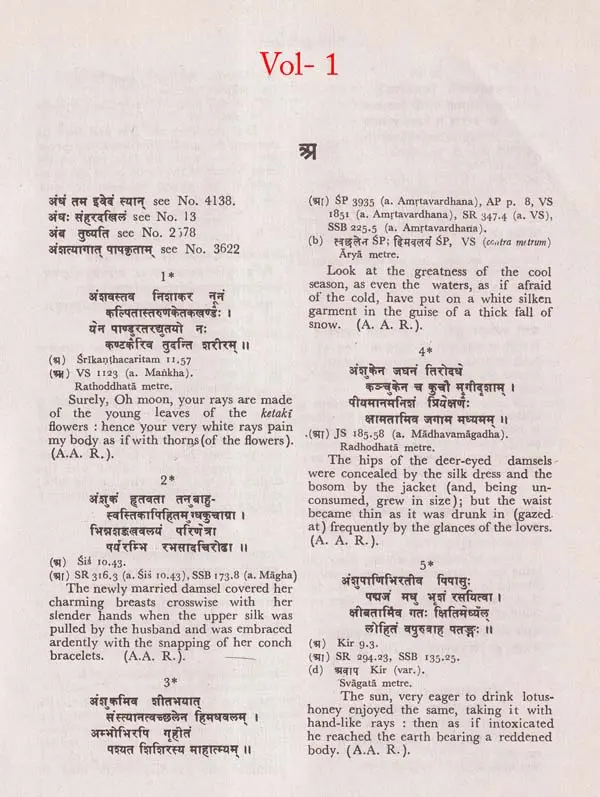








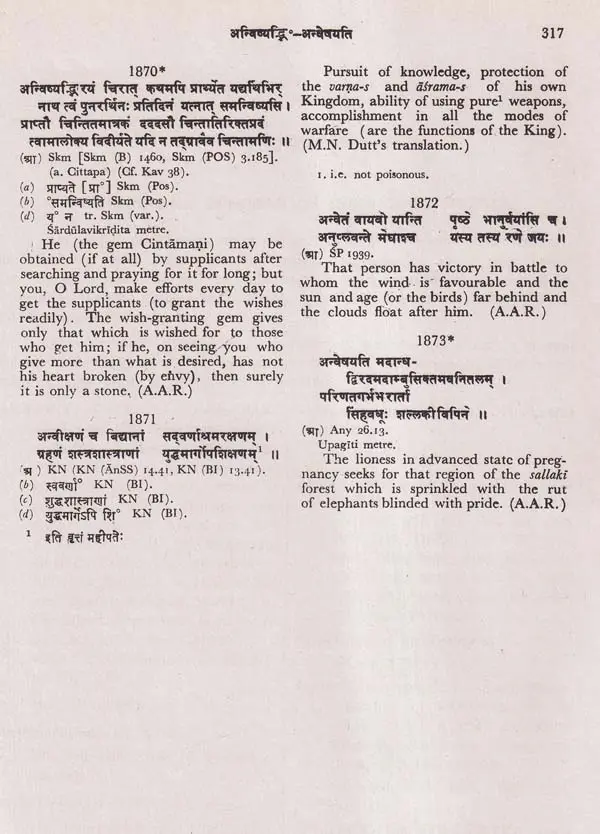





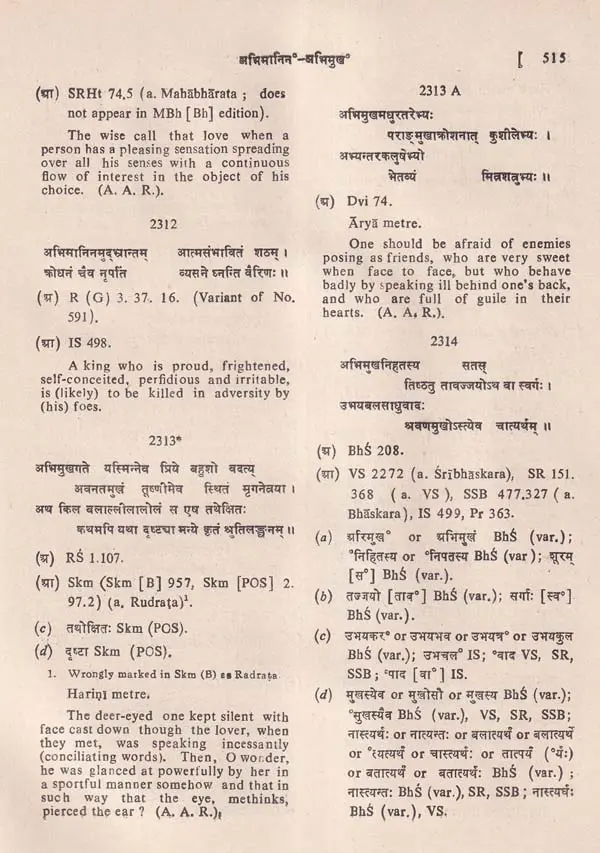



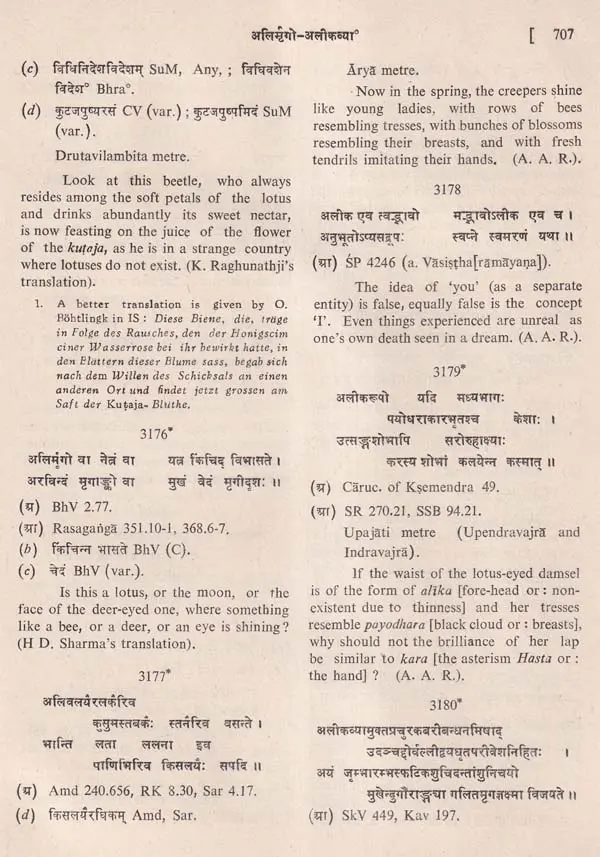














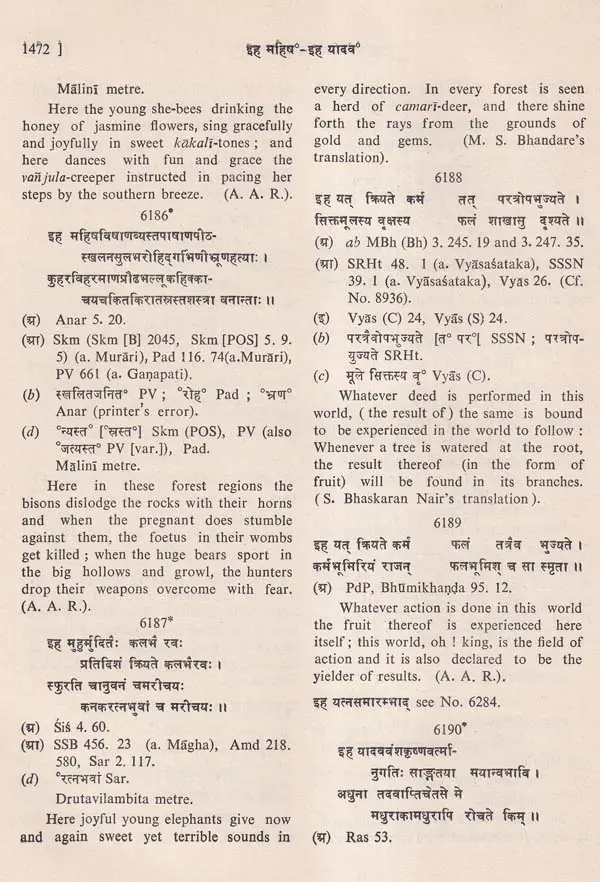
















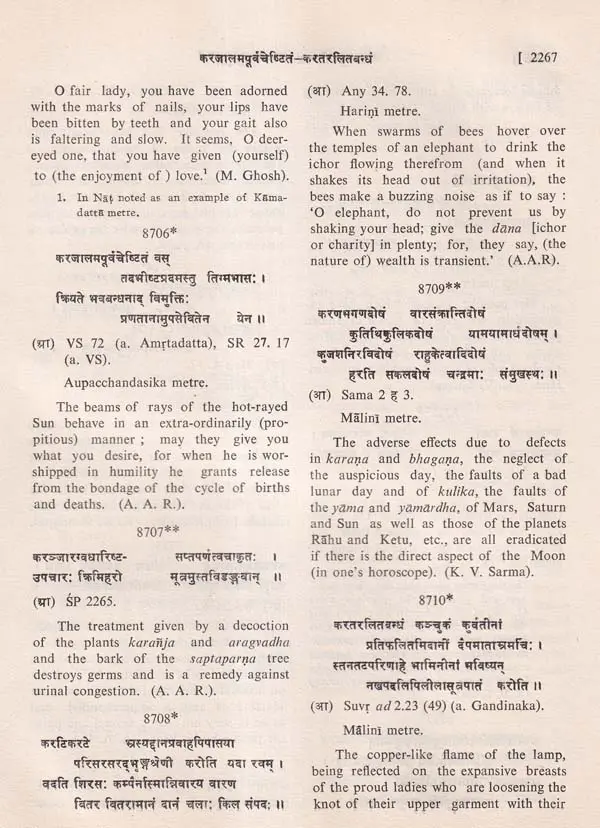




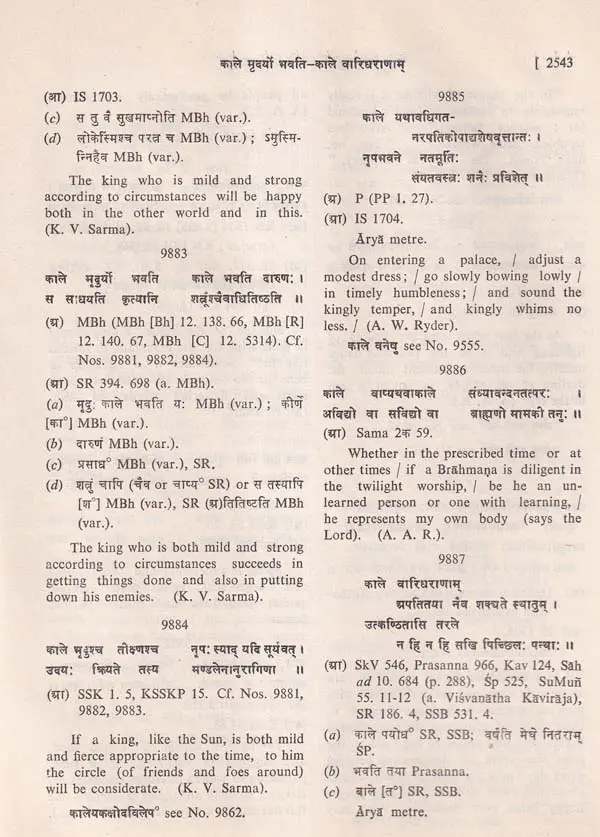












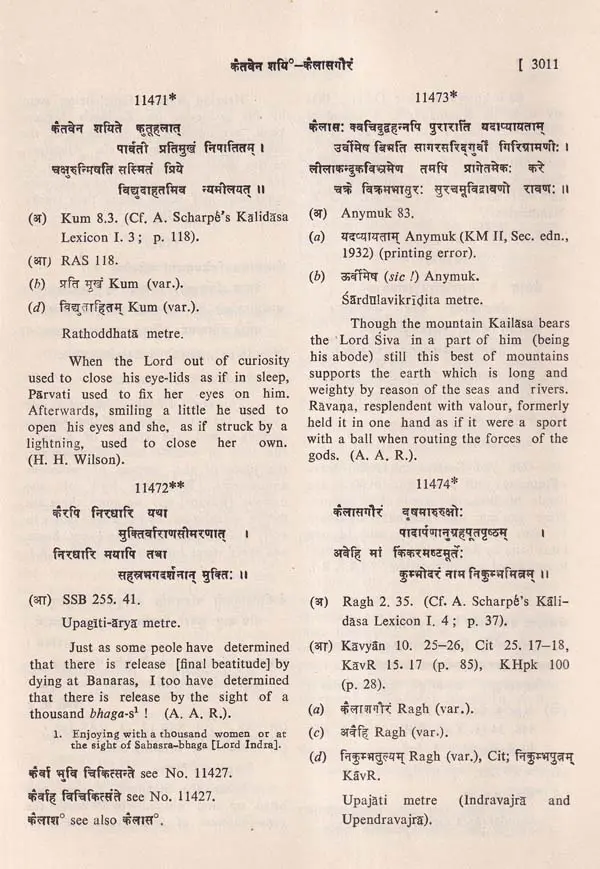





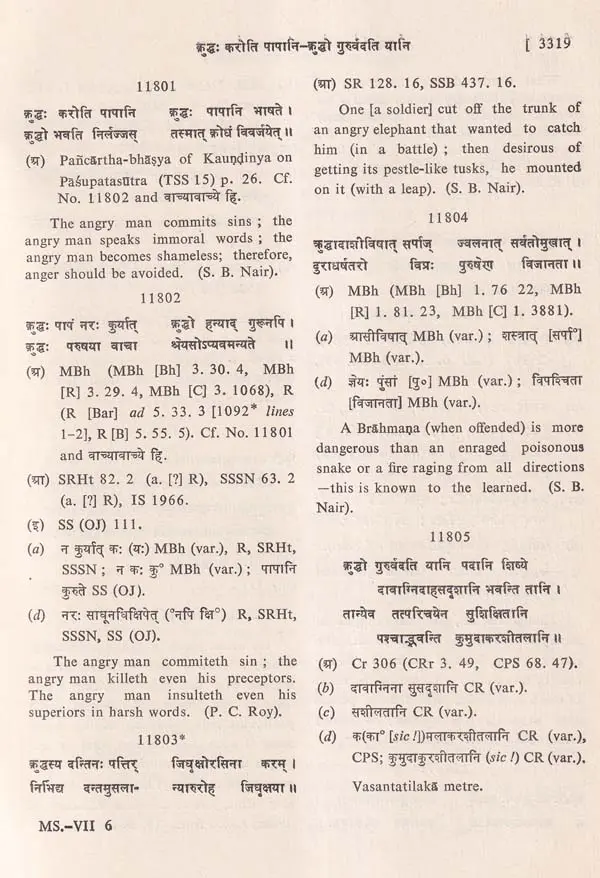


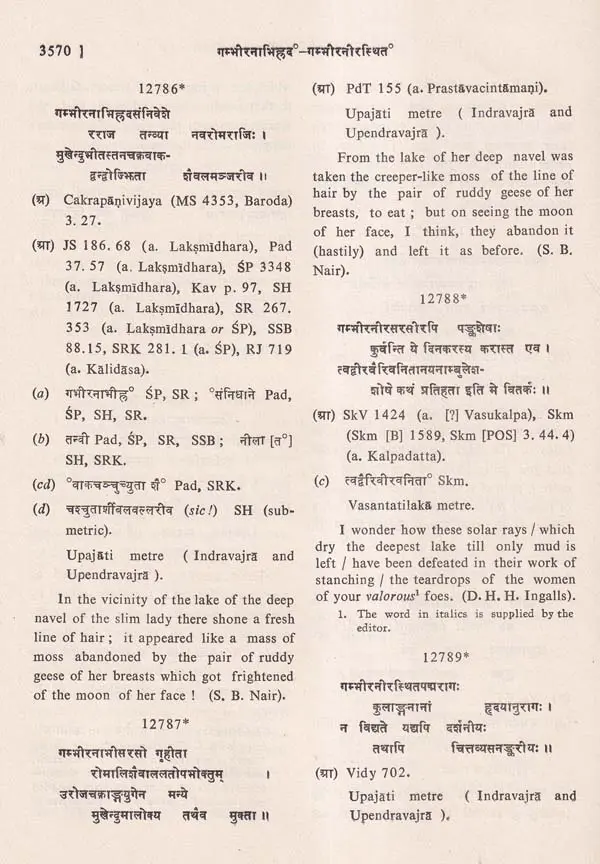




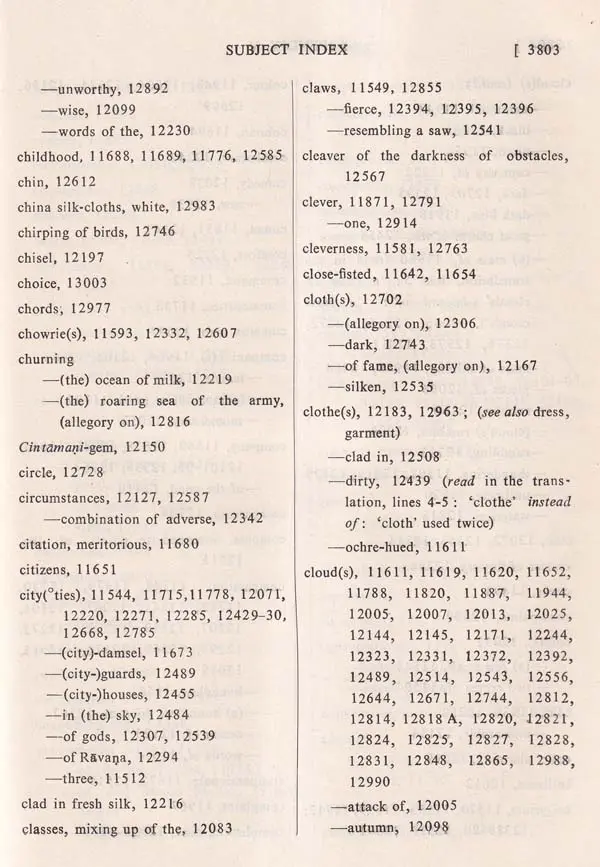









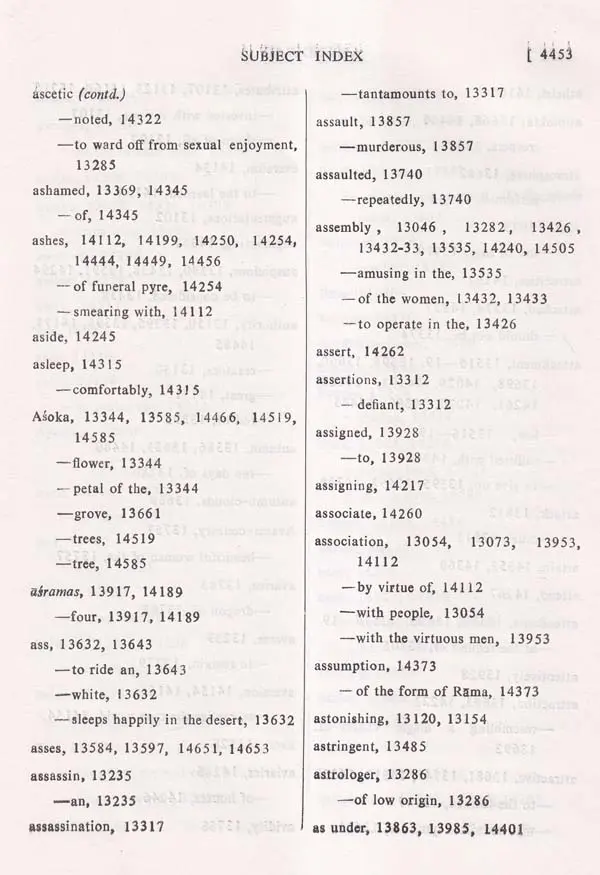


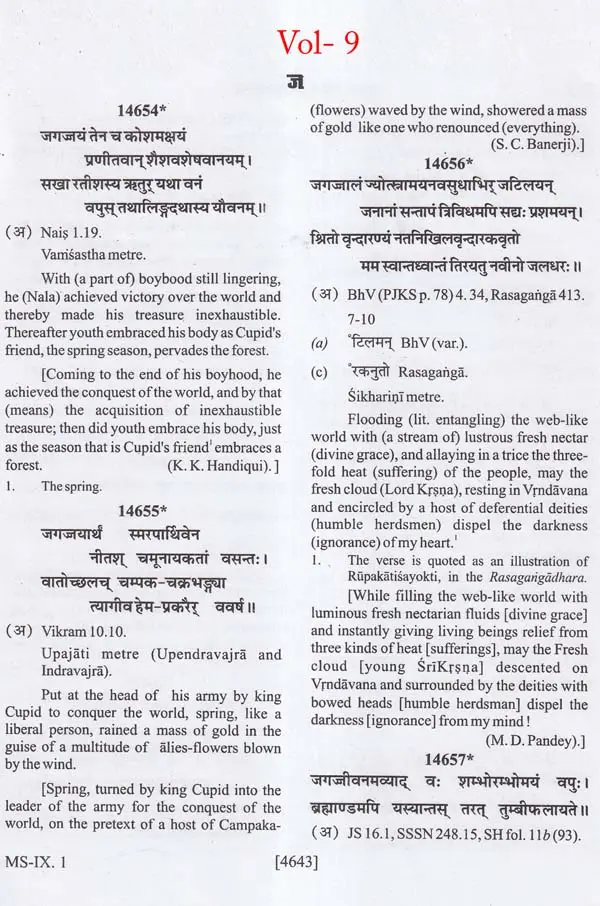





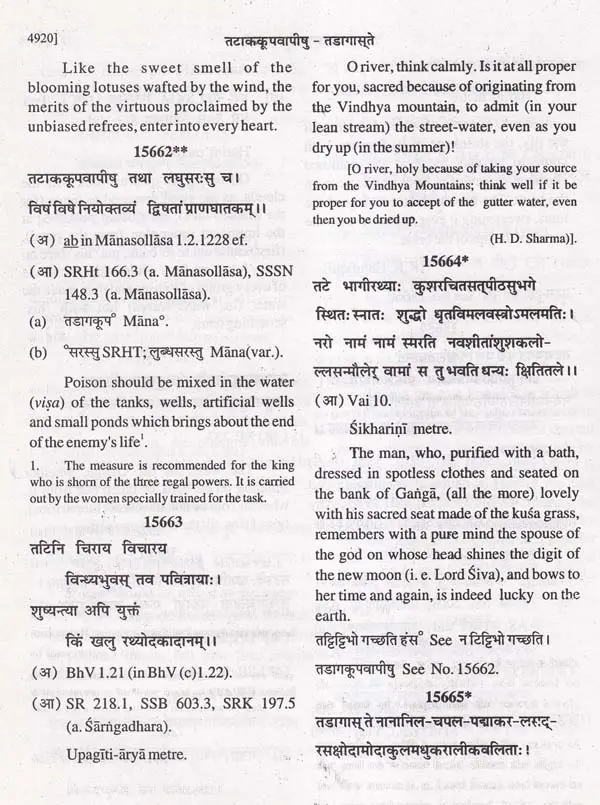



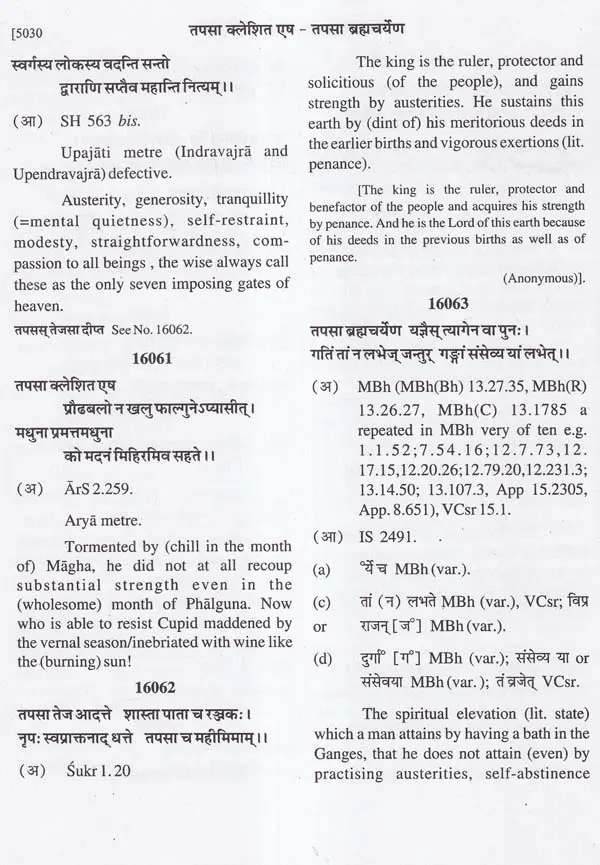

Send as free online greeting card
